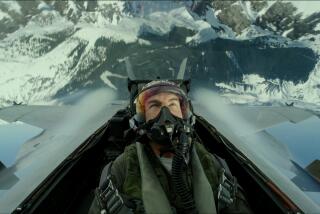S.D. Firms Still Target the ‘Top-Gun’ Market : Defense: Despite end of Cold War, they see continuing prospects in high-tech military training.
It’s no secret that improved super-power relations are forcing the the Defense Department to cut budgets of programs that, in Cold War days, were viewed as essential.
But executives at two San Diego-based companies that depend heavily upon military contracts believe that Uncle Sam will continue to purchase certain kinds of products, including high-tech systems that teach flight crews the mechanics of modern warfare.
Cubic Corp. and Applied Data Technology have acknowledged that the Defense Department won’t be buying as many training systems as it has. But executives at both companies expect the Pentagon to shift its emphasis to products that enhance existing training systems.
“You’re going to see a change in the basic approach,” Applied Data Technology spokesman Rod Powers said Monday. “There is going to be more of an emphasis of upgrading what you’ve got and tying your assets together.”
The two companies in the past have competed mainly for so-called “Top Gun” training systems, the high-tech systems that electronically track aircraft as they engage in mock dogfights. During subsequent sessions, instructors use the accumulated data, which is displayed on massive screens, to critique crew performances.
Although Cubic and Applied Data Technology will continue to compete for Top Gun systems, they increasingly will be chasing multi-service contracts that are designed to link training systems that now operate independently. Cubic, for example, in March won a $9.3-million contract to link air- and ground-training systems.
The “Air Warrior” contract will be the first to provide for training air and ground forces in an integrated manner, U.S. Rep. Duncan Hunter said when the contract was announced.
When operational, Air Warrior will allow field commanders to conduct ground and air exercises “as a joint effort, much like the battles that took place in Operation Desert Storm,” Hunter said.
The system will link the Army’s National Training Center at Ft. Irwin in the Mojave Desert with Nellis Air Force Base in Nevada. Instructors will be able to “live and, in real time . . . see the training scenario on huge color screens,” Hunter said.
Soldiers and flight crews will study the electronic records to learn “what they did right and what was done wrong, so that improvements in tactics and methods can be made,” a Hunter spokesman said.
Besides linking now-separate training systems, the Defense Department is striving to make its existing systems more realistic and more accessible.
Applied Data Technology, which won its first air-crew training contract in 1989, last week was awarded a $4.9-million contract to improve the graphics displays of several existing Navy and Air Force training systems.
Existing systems “in effect, have little stick figures,” Powers said. “This will take training into the Nintendo world . . . so pilots will see . . . buildings that look like real buildings, airplanes that look like real airplanes.” When the system is operational, pilots sitting in debriefing sessions will “see afterburners kick in, and wing slats move,” Powers said.
The improved, three-dimensional graphics are expected to dramatically bolster the training value of the existing systems, Powers said.
Applied Data Technology’s most recent contract also calls for the company to install technology that will expand the number of flight crews that can use existing training systems. Crews now must fly into the relative handful of bases with Top Gun systems. Applied Data Technology will provide technology that will allow aircraft to conduct post-session reviews at their home bases.
For years, Cubic was the sole supplier of the high-tech “Top Gun” systems that the Navy and Air Force used to train air crews. Although Cubic now has competitors in the narrow field, the systems remain an important business segment for the company. Electronic defense systems accounted for $145.5 million of Cubic’s $352.8 million in 1990 revenue.
Cubic’s longstanding lock on the market was broken in 1989 when Merrimack, N.H.-based Kollsman won a $26.7-million contract to supply air-combat maneuvering instrumentation ranges for Air National Guard bases in Alaska and Wisconsin.
Privately held Applied Data Technology acted as a subcontractor to Kollsman on that initial award. The company since has upgraded a training system at Langley Air Force Base in Virginia and recently won a contract to repair systems for the Navy and the Air Force.
Applied Data Technology now has about 75 employees. The company will hire an as-yet-undetermined number of new employees to complete the latest contract.
More to Read
Inside the business of entertainment
The Wide Shot brings you news, analysis and insights on everything from streaming wars to production — and what it all means for the future.
You may occasionally receive promotional content from the Los Angeles Times.










